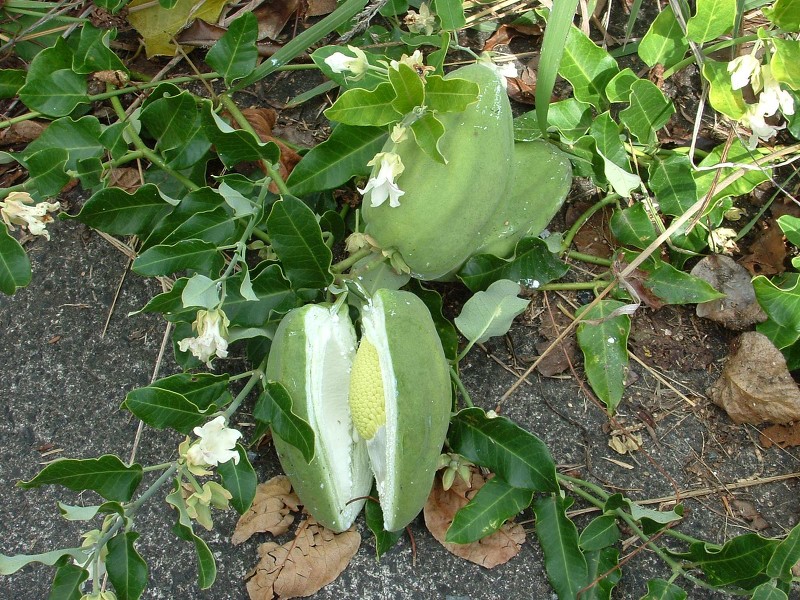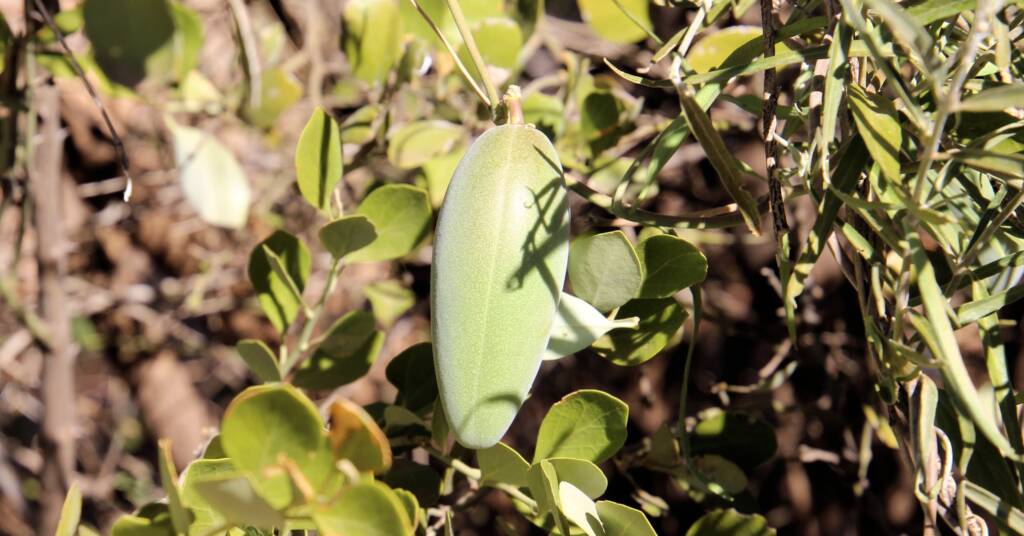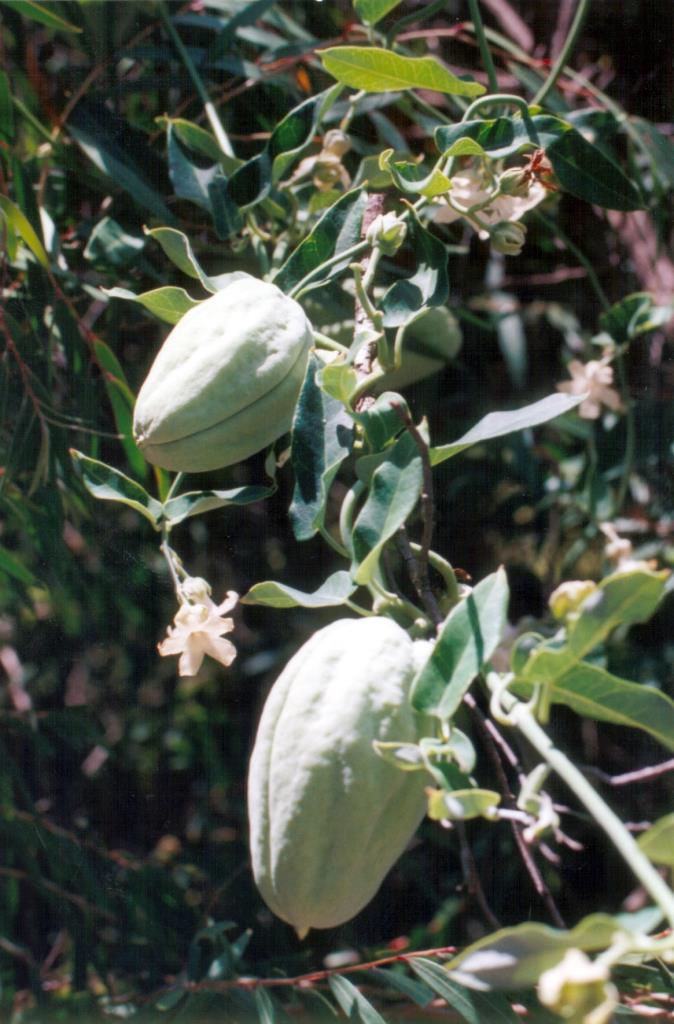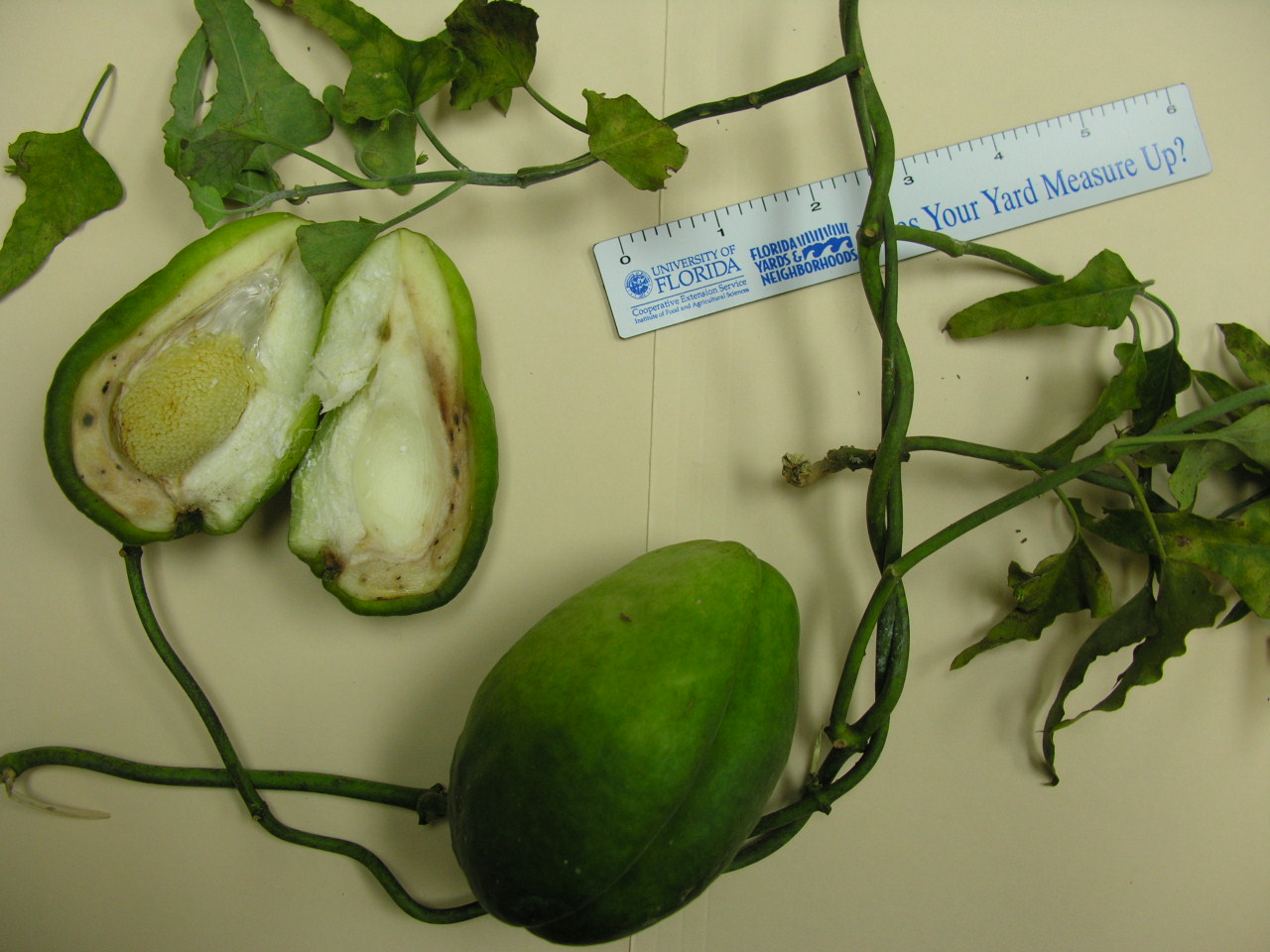I have seen and eaten a few fruits of a plant growing in NSW that I was convinced was an Australian "Bush Banana", or Yuparli in Warlpiri, that I've seen and eaten many times with Aboriginal people at Yuendumu. My mother on her visits to NSW has also picked and eaten these fruits with us, also convinced that it was the same fruit. On a recent scout-camp weekend I found and the kids ended up picking heaps of these fruits, which I cooked on the BBQ and shared with everyone, very confident and telling them all about how it was Yuparli.

Bush Banana or Yuparli
Today one of the mothers approached me and asked "are you sure about that plant? I've looked online and it looks very much like something called Moth-Vine which is poisonous". My initial reaction was "Nah, no way", but then I started searching online for "Moth Vine" and wow, yeah, it really does look the same, and there are lots of pages claiming it is poison. Hmm... that doesn't sound good. But... but... it looks, smells, and even tastes exactly like Yuparli! It can't be poisonous!

Moth Vine
So I started digging more. Strangely I couldn't seem to find a single page that mentioned "Bush Banana" and "Moth Vine" on the same page. Not a single "huh, that's strange, they are almost identical" page. So I started digging more.
Yuparli, AKA Bush Banana's scientific name is marsdenia australis and is native to Central and Western Australia. It is a well known and documented Aboriginal Bush Tucker.

Marsdenia Australis, AKA Bush Banana, or Yuparli in Warlpiri
Moth Vine, AKA Bladderflower, Bladder Vine, Common Moth Vine, Cruel Plant, Cruel Vine, False Choko, Moth Plant, White Bladder flower, White Moth Vine, is Araujia sericifera and comes from South America. It has a reputation for being poison, but it's not clear exactly how poisonous. Some sources limit the warnings to "exudes a milky latex that can cause allergic reactions". Others also say "Poisonous to livestock (cattle), domestic animals (poultry and dogs) and humans". The more alarmist "Woman shocked when she found out what plant was" click-bait articles make it sound like you die if you look at it too long.

Araujia Sericifera, AKA Moth Vine
So what exactly had I been eating (and feeding to others)? The photos of Moth Vine online look exactly like what we were eating. Photos of Yuparli online don't look exactly the same, with the fruit being smoother than the Moth Vine photos which are a bit wrinklier. But those photos show Yuparli fruit at the early (and yummy) stage of development. What they don't show is what Yuparli looks like as the fruit ages, and it goes wrinklier, eventually going woody, drying out, and splitting to spread the feathered seeds. They look exactly the same, they smell exactly the same, and they taste exactly the same.
Except... they weren't exactly-exactly the same. There were subtle differences; they were bigger, they were a bit more wrinkly, and I remember Yuparli tasting a tiny bit sweeter. These were mostly within the range and what you would expect with Yuparli, which do get less sweet and more wrinkly as they get bigger. So these seemed like normal Yuparli, just slightly bigger and more over-ripe than normal. Certainly less differences than you get with different varieties of tomato. So I assumed these subtle differences were down to environmental effects; better soil and more rain, makes them grow bigger, which makes them a bit wrinklier and slightly less sweet.
I have seen similar other variants of these plants in NSW. There is one that has darker, harder, smoother, fruit with a waxy sort of coating. These looked too different for me to trust, but my Mum says she'd heard of other Aboriginal people eating those ones too. I think these might be marsdenia rostrata and there does seem to be some websites also calling these "bush banana". It could also have been Marsdenia floribunda but that would have been introduced from Madagascar. After looking at lots of photos of related plants, and seeing how subtle the differences can be, I now think it wasn't Yuparli, but it was a very very similar plant.
So if it really was Moth Vine, how poisonous could it actually be? It's in the Araujia family which also have a common name (that they share with marsdenia) of "milk vine". A search for "milk vine" stumbled on these;

Araujia Odorata or Milkweed Vine
- https://www.eattheweeds.com/morrenia-odorata-pest-or-pleasure-food-2/
- http://lepcurious.blogspot.com/2012/10/milkweed-vine.html
- https://www.youtube.com/watch?v=LjMHCB6nXbw
These are talking about another very similar plant they call "Milkweed Vine" or Morrenia Odorata (now called Araujia Odorata) classified as a weed in North America, but documented as a highly esteemed and even cultivated food eaten by Native South Americans. It has references that say "all of the Morrenia species are edible". Since Morrenia seems to have been renamed to Araujia, that would imply that "all the Araujia species are edible" and Moth Vine is an Araujia. It does mention that "the latex in the vegetable can irritate the mouth", and also "The plant, interestingly, is toxic to cows and usually fatal". The plant in the video in particular looks exactly the same as the Moth Vine images and plants we were eating. The description of how the plants are used, prepared, and the best ripeness and parts to eat are almost identical to what Aboriginal people do with Yuparli. The descriptions of the taste are also very similar. The seeds and fibers are to be avoided, and the more mature fruit are less tasty.
There are other pages talking about eating "milkweed pods", but although these are clearly similar, they are also very different to the Yuparli, Moth Vine, and Milkweed Vine images above because they have spiky pods;
So it looks like there are many very similar and not-so-similar variants of Morrenia/Araujia and Marsdenia from South America and Australia that are eaten and prepared in similar ways by native people on both continents. Many of these variants are so similar they are hard to distinguish, even though they might originate from completely different continents, and are probably often miss-identified.
Someone pointed me at an authoritative database that includes "occurrence maps". The Moth Vine distribution map shows them tightly clustered along the East Coast. The Bush Banana distribution map shows them distributed all over Australia, including some along the East Coast. However, it would not surprise me at all if those East Coast occurrences were actually miss-identified Moth Vine.
So was it Moth Vine? Probably, but there are enough very similar native plants that it could have been something else, and it wouldn't surprise me if many plants identified as Moth Vine, and maybe even some online photo's of them, are actually miss-identified native Marsdenia variants. It might even have been another non-native variant like Morrenia Odorata. Maybe it could even be a hybrid between different varieties?
Was it poisonous? Probably not. As with many plants, it probably comes down to which parts you do vs don't eat and how you prepare them. Apple seeds contain cyanide, and Rubarb contains very toxic oxalic acid until it's cooked. I would not eat the seeds (they probably taste bitter for a reason), and avoid too much contact with the milk. Definitely don't feed it to your cow or dog. But otherwise it's probably fine, tasty, and a traditional South American food.
So weirdly, it looks like I might have made a mistake and not been eating/sharing Australian bush-tucker, but South American bush-tucker.
What lesson can be learned? Bush knowledge is highly localised! I grew up in Central Australia with Aboriginal people and have a pretty good knowledge of bush tucker from that region. In the NSW bush I can see that the land is much richer with much more plants and animals, and there must be heaps of food that would have supported a much denser Aboriginal population. But I don't know where or how to find it! Even when I was confident my Central Australian knowledge translated for this particular plant, it looks like I was slightly wrong.
Living off any land requires many many generations of accumulated local knowledge and systematic lifelong education to teach it. Without that knowledge survival is a struggle, but with it people have populated and thrived in nearly every different ecosystem on earth.